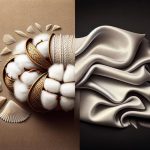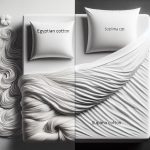When you're deciding between Pima cotton and Egyptian cotton, it's important to weigh the unique qualities each type offers. Pima cotton is known for its softness and durability, making it a practical choice for everyday use. On the other hand, Egyptian cotton boasts a luxurious feel and breathability, appealing to those who appreciate finer textiles. So, which one truly meets your needs? Understanding the key differences and benefits of each can help you make an informed decision that aligns with your lifestyle. Let's explore what sets these two cottons apart.
Table of Contents
Overview of Pima Cotton
Pima cotton, known for its luxurious softness and durability, is a premium fiber cultivated primarily in the United States. You'll appreciate its long, silky fibers that contribute to a smooth finish and reduce fraying, fading, and wrinkling. This cotton is often blended into high-quality textiles, making it a popular choice for upscale clothing, bed linens, and towels.
When you touch Pima cotton, you'll notice the difference immediately. It feels softer against your skin compared to standard cotton, enhancing your comfort. This fiber is also more resistant to wear and tear, meaning your garments and linens will last longer, saving you money in the long run.
In addition to its physical attributes, Pima cotton is also known for its vibrant colors. Its ability to absorb dye well means you can enjoy richer hues in your fabrics. Plus, it's grown in a way that emphasizes sustainable practices, which is an added bonus if you're environmentally conscious.
Overview of Egyptian Cotton
Egyptian cotton is renowned for its exceptional quality and luxurious feel, making it a top choice for high-end textiles. This cotton variety is cultivated along the Nile River, where the unique climate and rich soil contribute to its superior characteristics. You'll appreciate its long fibers, which result in softer, stronger, and more durable fabric. When you choose Egyptian cotton, you're investing in comfort and longevity.
Here are some key features that set Egyptian cotton apart:
- Long Staple Fibers: These fibers contribute to a smoother texture and prevent fraying, fading, and tearing.
- Breathability: The natural fibers allow for better airflow, making it ideal for warm climates and comfortable sleep.
When you're considering fabrics for your bedding or clothing, Egyptian cotton stands out for its ability to combine luxury with practicality.
It's no wonder many luxury brands use this cotton to create products that feel exquisite and last for years.
Key Differences Between Cottons
When comparing these two premium cotton types, you'll notice distinct differences in their fiber length, cultivation methods, and overall feel.
Pima cotton, primarily grown in the United States, boasts longer fibers, typically measuring around 1.4 to 2 inches. This length contributes to its silky softness and durability. On the other hand, Egyptian cotton, cultivated in the Nile River Valley, is also known for its long fibers, often exceeding 1.5 inches. However, the unique climate and soil conditions in Egypt give it a different texture and luster.
In terms of cultivation, Pima cotton is usually produced in controlled environments, focusing on quality over quantity. Egyptian cotton is often hand-picked to ensure the fibers remain intact, which enhances its overall quality.
You'll also notice a difference in feel. Pima cotton has a luxurious, smooth texture, making it ideal for high-end sheets and garments. Egyptian cotton, while also soft, has a slightly crisper finish, giving it a distinct character.
Both types offer exceptional quality, but understanding these key differences will help you choose the best option for your needs.
Benefits of Each Cotton Type
Choosing between Pima cotton and Egyptian cotton can enhance your comfort and style, as each offers unique benefits tailored to different preferences.
When you consider Pima cotton, you'll appreciate its luxurious softness and durability. It's known for having longer fibers, which contribute to a smooth texture that feels great against your skin. Plus, Pima cotton resists fading and fraying, ensuring your garments maintain their quality over time.
On the other hand, Egyptian cotton is renowned for its breathability and moisture-wicking properties. This makes it an excellent choice for hot climates or those who tend to sweat at night. Egyptian cotton's long staple fibers also provide an exceptional level of strength, making it less prone to tearing.
Here are some benefits of each cotton type:
- Pima Cotton: Exceptional softness and durability; resists fading and fraying.
- Egyptian Cotton: Highly breathable; excellent moisture-wicking properties; strong and long-lasting.
Whichever you choose, you'll enjoy the quality and comfort that these cotton types provide.
Choosing the Right Cotton for You
Deciding between Pima cotton and Egyptian cotton depends on your specific needs and preferences for comfort and functionality.
If you're looking for luxurious softness and a lustrous finish, Egyptian cotton might be your best bet. It's known for its long, silky fibers that create a smooth, premium feel, perfect for bed linens and high-end garments.
On the other hand, if durability and ease of care are your priorities, Pima cotton shines. Its strong fibers resist fraying and fading, making it ideal for everyday wear and household items. Plus, Pima's breathability keeps you comfortable in various climates.
Consider your lifestyle, too. If you frequently wash your cotton items, Pima's durability may save you money in the long run. However, if you value the prestige and feel of luxury fabrics for special occasions, Egyptian cotton could be worth the investment.
Ultimately, it's about what fits your needs. Take a moment to assess how and where you'll use the cotton items. That way, you can confidently choose the type that best aligns with your preferences and lifestyle.
Happy shopping!
Frequently Asked Questions
Can Pima Cotton Be Blended With Other Fabrics?
Yes, you can blend Pima cotton with other fabrics like polyester or spandex. This combination enhances durability and stretch while maintaining the softness and breathability that Pima cotton is known for. Enjoy versatile clothing options!
How Sustainable Are Pima and Egyptian Cotton Farming Practices?
When considering sustainability, you'll find both Pima and Egyptian cotton farming practices vary. Pima often uses less water and fewer chemicals, while Egyptian cotton can involve more intensive irrigation. Research specific farms to get the full picture.
What Is the Lifespan of Pima and Egyptian Cotton Products?
The lifespan of cotton products depends on care and usage. Generally, if you wash and store them properly, you can expect Pima and Egyptian cotton to last several years, maintaining quality and softness throughout.
Are There Specific Care Instructions for Each Cotton Type?
You should wash both types of cotton in cold water to prevent shrinking. Avoid bleach, and tumble dry on low. Iron on a medium setting if needed, ensuring you preserve their softness and longevity.
How Do Pima and Egyptian Cotton Compare in Terms of Cost?
When comparing costs, you'll find Pima cotton typically priced higher due to its superior quality and softness. Egyptian cotton can also be expensive, but you might discover more affordable options depending on the brand and quality.
- Tetron Fabric for Marine Applications: Durability and Use Cases - June 18, 2025
- Tetron Fabric for Outdoor Furniture: Weather Resistance and Care - June 18, 2025
- Tetron Fabric for Wall Coverings: Style and Application Tips - June 18, 2025







